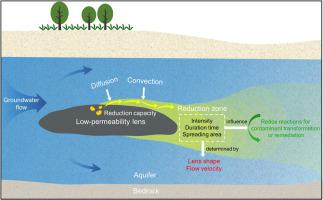当前位置:
X-MOL 学术
›
Water Res.
›
论文详情
Our official English website, www.x-mol.net, welcomes your feedback! (Note: you will need to create a separate account there.)
Reduction capacity in the transmissive zones fueled by the embedded low-permeability lenses: Implications for contaminant transformation in heterogeneous aquifers
Water Research ( IF 11.4 ) Pub Date : 2024-06-17 , DOI: 10.1016/j.watres.2024.121955 Hong Wang , Yonghui Zhu , Yuxi Lu , Xiaochuang Bu , Qi Zhu , Songhu Yuan
Water Research ( IF 11.4 ) Pub Date : 2024-06-17 , DOI: 10.1016/j.watres.2024.121955 Hong Wang , Yonghui Zhu , Yuxi Lu , Xiaochuang Bu , Qi Zhu , Songhu Yuan

|
Redox conditions play a decisive role in regulating contaminant and nutrient transformation in groundwater. Here we quantitatively described and interpreted the temporal and spatial variations of aquifer reduction capacity formation in lens-embedded heterogeneous aquifers in 1-D columns. Experimental results indicated that the aquifer reduction capacity exported from the low-permeability lens permeated into the downstream sandy zones, where it subsequently accumulated and extended. Reactive transport modeling suggested that reduction capacity within the lens preferentially diffused to the transmissive zones around the lens-sand interface, and was then transported via convection to downstream transmissive zones. A low-permeability lens of the same volume, but more elongated in the flow direction, led to less concentrated reduction capacity but extended further downgradient from the lens. The increased flow velocity attenuated the maintenance of aquifer reduction capacity by enhancing mixing and diluting processes in the transmissive zones. The reduction zones formed downstream from the low-permeability lens were hotpots for resisting the oxidative perturbation by O. This study highlights the important role of low-permeability lenses as large and long-term electron pools for the transmissive zones, and thus providing aquifer reduction capacity for contaminant transformation and remediation in heterogeneous aquifers.
中文翻译:

嵌入式低渗透性透镜推动的透射区的减少能力:对异质含水层中污染物转化的影响
氧化还原条件在调节地下水污染物和养分转化方面起着决定性作用。在这里,我们定量描述和解释了一维柱中透镜嵌入的异质含水层中含水层减少能力形成的时间和空间变化。实验结果表明,低渗透透镜体输出的含水层减少能力渗透到下游沙区,并在此积累和扩展。反应传输模型表明,透镜内的还原能力优先扩散到透镜-沙子界面周围的透射区域,然后通过对流传输到下游透射区域。体积相同但在流动方向上更长的低渗透性透镜导致集中减少能力较小,但从透镜向下延伸得更远。增加的流速通过增强传输区域中的混合和稀释过程来减弱含水层减少能力的维持。低渗透率透镜下游形成的还原区是抵抗 O 氧化扰动的热点。这项研究强调了低渗透率透镜作为透射区的大型和长期电子库的重要作用,从而提供含水层还原异质含水层中污染物转化和修复的能力。
更新日期:2024-06-17
中文翻译:

嵌入式低渗透性透镜推动的透射区的减少能力:对异质含水层中污染物转化的影响
氧化还原条件在调节地下水污染物和养分转化方面起着决定性作用。在这里,我们定量描述和解释了一维柱中透镜嵌入的异质含水层中含水层减少能力形成的时间和空间变化。实验结果表明,低渗透透镜体输出的含水层减少能力渗透到下游沙区,并在此积累和扩展。反应传输模型表明,透镜内的还原能力优先扩散到透镜-沙子界面周围的透射区域,然后通过对流传输到下游透射区域。体积相同但在流动方向上更长的低渗透性透镜导致集中减少能力较小,但从透镜向下延伸得更远。增加的流速通过增强传输区域中的混合和稀释过程来减弱含水层减少能力的维持。低渗透率透镜下游形成的还原区是抵抗 O 氧化扰动的热点。这项研究强调了低渗透率透镜作为透射区的大型和长期电子库的重要作用,从而提供含水层还原异质含水层中污染物转化和修复的能力。











































 京公网安备 11010802027423号
京公网安备 11010802027423号